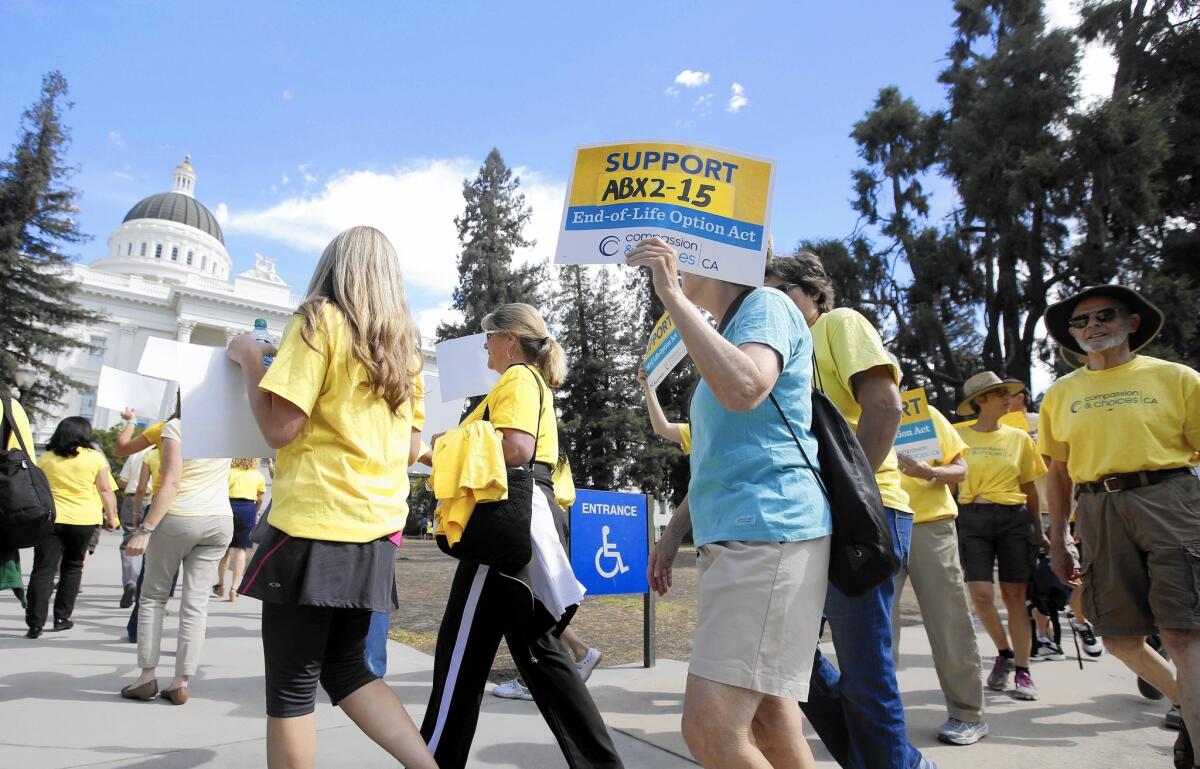Death With Dignity Act in Oregon: A preview of what California might expect

Supporters of a California measure to allow the terminally ill to end their own lives march at the state Capitol in September 2015.
With a stroke of his pen, Gov. Jerry Brown more than tripled the number of people in America who will be able to ask a doctor to help them die if they are terminally ill and have no more than six months to live.
California’s new law, which the 77-year-old former Jesuit seminarian struggled with before signing, was modeled after legislation enacted in Oregon nearly 18 years ago. Whether they call it “death with dignity” or the “corruption of the medical profession,” “physician-assisted suicide” or “medical killing,” those on both sides of the end-of-life debate do agree on one thing:
That Oregon’s example offers important lessons for California and its 38.8 million residents, who in the near future will be able to ask a doctor to prescribe them a lethal dose of medication so they can hasten their own deaths.
George Eighmey, vice president of the Death With Dignity National Center, and Dr. William L. Toffler, national director of Physicians for Compassionate Care, weighed in on Oregon’s experience at this teachable moment for the most populous state in America.
The medication itself
When Oregon’s Death With Dignity Act first went into effect, doctors would prescribe pentobarbital and secobarbital, said Eighmey, a former state legislator. “But pentobarbital is no longer available. The manufacturer refused to send it to the U.S. because it’s used in the three-drug combination for death penalty cases.”
After trying various alternatives and watching prices rise, Oregon physicians settled this year on a combination of phenobarbital, chloral hydrate and morphine sulfate, mixed with 200-proof ethanol. It is prescribed and taken in liquid form, Eighmey said, and a 4-ounce dose costs $450 to $500. An hour before taking the drugs, patients also take an antiemetic to ward off vomiting and nausea.
Does the combination always work?
The most recent formula has been used by about four dozen people, Eighmey said, and has been successful.
“A person goes into a coma within five minutes and dies in less than an hour, and it’s very peaceful,” said Eighmey, who is not a doctor but who was involved in nearly 50 cases that used an earlier drug protocol. “We, of course, warn people that it can be longer.... We had one person, a very heavy person, who took 103 hours.”
But Toffler, a professor of family medicine at Oregon Health & Science University, is a vehement opponent of his state’s landmark law. He points to the fact that some people have not died from the intended overdose. He also believes the drug combo is too difficult to take.
“If you don’t drink it fast enough, you will fall asleep before you take a sufficient amount,” said Toffler, who does not speak on behalf of the university. “If you drink it too quickly, you throw up, because it’s such a bitter medication.”
Eighmey scoffs at such concerns and said Oregon’s experience disproved the allegations made by the law’s opponents.
“They said that 25% of the people would wake up after taking the medication,” Eighmey countered. “But only 6 out of nearly 1,000 who have taken the medication awakened. All decided not to take the medication again, except for one. That person took it a week later and died peacefully.”
Who uses this?
Another concern raised by the law’s opponents, Eighmey said, was that “we will prey upon minorities and women and poor people. These will be the people who will use the law the most frequently because they can’t afford the medical care necessary. And the rich will get the best treatment to keep themselves alive.”
According to the Oregon Public Health Division’s 2014 annual report, 95.2% of the patients who used physician-assisted suicide were white and nearly half had college degrees. More than two-thirds were 65 or older, and the median age at death was 72.
State data
Since the law was enacted in 1997, according to state statistics, 1,327 people have had what the health department calls “DWDA prescriptions,” and 859 have died from taking the medication.
In 2014, 155 such prescriptions were written, 94 patients took the medication, and all died from it. None regained consciousness, the state says. Of those with prescriptions, 37 did not take the medication and eventually died of other causes. The status of 24 others is unknown.
Toffler said he has serious reservations about the health department’s statistics because the government “controls the reporting. We don’t know about people who took the overdose. It suppressed their breathing, they had a stroke, but did not die. You’d never hear about that.”
During the nearly 18 years that physicians have been allowed to prescribe medications to help patients die, several cases have highlighted concerns with the law. Among the most high profile was Barbara Wagner, a 64-year-old great-grandmother with end-stage lung cancer.
Her doctor prescribed an expensive regimen of chemotherapy in 2008, a last shot at extending her life. Her state insurance plan refused to authorize it and instead sent her a letter offering comfort care, including “physician aid in dying.”
The drug company eventually provided the drug at no cost, according to the Oregonian, but she lived only a short time longer.
Impact on hospice care
One of the Death With Dignity Act’s greatest successes, Eighmey said, is its impact on hospice care for those at the end of life.
Opponents of the act warned that terminal patients would be encouraged to take medication to hasten their deaths rather than enroll in hospice care to make their final months as comfortable as possible.
Oregon Public Health Division statistics show that 93% of the patients who received a prescription to hasten their deaths were enrolled in hospice care at the time the prescription was written or when they died.
And, according to the Oregon Hospice Assn. website, the state is No. 6 nationally for high hospice usage. The most recent Medicare data showed that in 2012, 53.2% of Medicare patients who died in Oregon were on hospice care, compared with 44.4% nationwide.
“This indicates that it’s not an either-or situation,” Eighmey said. “You can be getting the quality of care at the end of life that makes life acceptable at the same time you’re taking the medication” to hasten death.
@marialaganga
More to Read
Sign up for Essential California
The most important California stories and recommendations in your inbox every morning.
You may occasionally receive promotional content from the Los Angeles Times.











